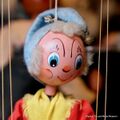Category:Noddy
Noddy was a popular children's book character created and written by Enid Blyton, and visualised by Dutch illustrators Harmsen van der Beek (from 1949-1953) and then Harmsen van der Beek (1953 onwards) that first appeared in 1949.
Concept
Noddy is a newly-made wooden toy that finds himself wandering lost in the woods and is discovered by Big Ears, who takes him to Toyland. Noddy ends up owning a house and a car, and the stories tend to be based on his childish attempts to understand and adjust to the rules and conventions of the society that he finds himself in, particularly in his dealings with authority figures (such as Mr. Plod, the policeman). The character (like Andy Pandy) is designed to be someone that young children can identify with.
Merchandising
The primary colours of Noddy with his yellow spotted scarf and blue "belled" cap, and his distinctive red-and-yellow car made the character ripe for merchandising, resulting in the sale of a lot of jigsaws.
Morestone (Budgie Toys) also produced a small range of Noddy and Big Ears vehicles,
Enid Blyton
Enid Blyton (1897-1968) was born into the suburban village of Beckenham, and decided at an early age to be a writer, despite the best attempts of her mother to discourage her. After entering an Arthur Mee children's poetry competition in 1911, Mee offered to publish her verses and encouraged her to produce more. Starting teacher training in 1916, Enid worked as a governess in 1920, a job that expanded to take in other local children until she was effectively running a small village school.
1920 marked the start of Enid's serious attempts to start producing material in her spare time, and she started producing children's poetry and children's plays, through the 1920s, along with The Enid Blyton Book of Fairies, The Book of Brownies, and a body of other material that helped establish her "brand" as a children's writer.
Her already prolific output increased steadily through the 1930s, 1940s and 1950s with the understanding that it was easier to write series of books based on the same characters and situations than having to start over each time. As well as versious series set in schools, this approach produced the books that she is best remembered for, the Famous Five and Secret Seven children's adventure books, and the Noddy series for younger children.
Noddy appeared in 1949, with pictures provided by Dutch illustrators Harmsen van der Beek, whose previous most notable work had been illustrating a "berry-based" character for a Dutch jam company. when "Beek" died in 1953, the illustrations work was taken over by Peter Wienk, a fellow Dutch illustrator at Beek's studio, who had already been assisting with the "Noddy" work due to the rate at which Blyton produced new books.
The range of books ended up numbering somewhere in the twenties.
Modern assessments
In retrospect, Blyton's works are often remembered for its expression of contemporary middle-class English post-war values and ethos, often ot the point of apparent parody this may on part be due to Blyton's "stream-of-consciousness" approach to writing which meant that her works tended to be less self-conscious or introspective than those of other writers.
Blyton's body of work is often criticised for the sense of entitlement of its characters, a lack of imagination in its scenarios, repetitive re-use of ideas, sexual, national and ethnic stereotyping, and a consciously-restricted "childish" vocabulary that, some have argued, while appealing to children because the language is "easy", also fails to help a child's vocabulary expand.
However, Blyton's works (with minor revisions requested by publishers to placate modern sensibilities) remain popular.
The Blyton characters' trite use of language, village mind-set, and and archaic mannerisms were lampooned in a series of one-off TV dramas, Five Go Mad in Dorset (1982), Five Go Mad on Mescalin (1983) and Five Go to Rehab (2012).
External links
Pages in category ‘Noddy’
This category contains only the following page.
Media in category ‘Noddy’
This category contains only the following file.
- Noddy marionette (Pelham Puppets).jpg 1,200 × 1,200; 583 KB



